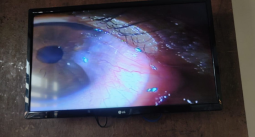
What is pterygium
A pterygium (ter-IJ-ee-um) is a raised, fleshy growth on your eye’s conjunctiva, the clear membrane that covers the white part of your eye. The growth may look whiteish or pinkish and may have visible blood vessels in it. It typically starts in the corner of your eye and grows toward your iris (the colored part).
Pterygium Before Surgery

Pterygium Before Surgery

Pterygium After Surgery

Pterygium After Surgery

Pterygium After Surgery

What causes a pterygium eye?
Pterygium is an overgrowth of your conjunctiva tissue. Causes include :
- Long-term exposure to the sun’s ultraviolet (UV) light.
- Chronic irritation from hot and dry weather, wind and dust.
Other possible risk factors include :
- Age over 60.
- Genetics.
- Vitamin A deficiency.
- Human papilloma virus (HPV).
Symptoms Of Pterygium
You might not feel your pterygium at first. You might only notice a raised, fleshy, wedge-shaped growth at the corner of your eye. When symptoms do develop, they can be mild to severe. They might include :
- Inflammation and swelling (conjunctivitis).
- Redness or bloodshot eye.
- Dry eye.
- Watery eye.
- A feeling like there’s something in your eye.
- Eye itching.
- Eye burning.
- Eye pain.
Over time, you might also notice:
- An increase in the size and spread of the lesion.
- Difficulties or discomfort with contact lenses.
- Vision changes, like blurred or double vision.
Not everyone develops these symptoms. Some pterygia grow more than others.
Prevention & Lifestyle Modification - Common FAQs
What can I do to lower my risk of pterygium?
- You can lower your risk of developing a pterygium — and slow its growth if you have one — by protecting your eyes from the elements, especially sunlight. Wear UV protection sunglasses when you’re in the sun. Protect your eyes from dry, windy, dusty climates by lubricating them with artificial tears.
What can I expect if I have a pterygium removed?
- There’s a small chance your pterygium will come back after surgery. If it does, it usually starts to appear within four months, and no later than 12 months after surgery. If you need to have another surgery, your surgeon will take extra measures to make sure the pterygium doesn’t come back again.
Treatment
An ophthalmologist can remove your pterygium.
During pterygium surgery, your ophthalmologist will :
- Give you anesthesia, so you won’t feel anything.
- Remove the abnormal tissue from the surface of your eye.
- Cover the hole left in your conjunctiva with other tissue.
Surgeons use different methods for patching the hole left after they remove your pterygium.
Medical Treatment
If the pterygium irritates your eye, your provider might prescribe :
- Over-the-counter (OTC) eye drops or eye ointments.
- A short course of steroid eye drops for severe symptoms.
Providers also recommend wearing hats and wraparound UV sunglasses to protect your eyes from further UV damage. This may help slow the growth of your pterygium or prevent it from growing faster. If your pterygium is growing toward your cornea, they’ll recommend removing it before it gets there.
Surgical Treatment
- Conjuctival autograft. Your surgeon may take a piece of conjunctiva tissue from elsewhere on your eyeball, usually from behind your upper eyelid, to patch the hole. This method leaves another wound behind your eyelid, but it’s well protected there and heals on its own.
- Amniotic tissue graft. Surgeons use donated amniotic membrane tissue (from a placenta) to cover the hole while it heals. This tissue acts as a bandage that protects your conjunctiva until it can grow back to cover the hole. This method is helpful when the gap is too big for an autograft.
Pterygium surgery takes about an hour. After surgery, you’ll wear an eye patch for a few days while you recover. It takes four to six weeks for your eye to heal completely.
Risks & Complications of pterygium surgery
The primary risk is recurrence (return of the pterygium after surgery). If this happens, you may need another surgery. Fortunately, with new and improved surgical techniques, rates of pterygium recurrence are declining. Current research suggests the rate of recurrence is somewhere between 2% and 15%.
Recurrence is more likely to occur if you don’t take your prescribed eyedrops as directed, or if your eye has direct sun exposure after surgery. It’s important to follow your provider’s instructions on this. You can still spend time outside, but if you do, make sure to wear protection, like a hat or sunglasses.
Prognosis
A pterygium won’t go away unless a surgeon removes it. It’s likely to grow slowly throughout your life. Most people won’t need treatment for a pterygium. If it irritates your eye, you can usually manage these symptoms with over-the-counter medications. If it’s more than a minor nuisance, you can remove it.
What happens if a pterygium isn’t removed?
Most pterygia will continue to grow, but some grow much more slowly than others. It’s possible that your pterygium will never bother you much. Because of the risk that it might grow back, healthcare providers don’t recommend surgery for a pterygium that’s small and doesn’t cause symptoms.

